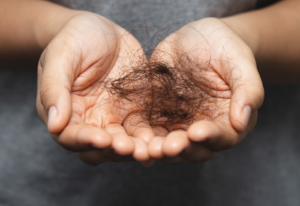Trichotillomania is more common than you think. In fact, according to the Anxiety Disorders Association of America, 5-10 million Americans are affected. Those who simply like to tug on their hair don’t necessarily have this disorder. However, if hair pulling leads to bald patches and discomfort, then it may be a problem.
What is Trichotillomania?
Trichotillomania is a mental health disorder characterized by recurrent and irresistible urges to pull out one’s own hair, resulting in noticeable hair loss or bald patches. Trichotillomania is classified as an obsessive-compulsive disorder (OCD), and it is often accompanied by other compulsive behaviors or disorders, such as skin picking or nail biting.
Trichotillomania can affect any part of the body where hair grows, including the scalp, eyebrows, eyelashes, and pubic area. People with trichotillomania may feel a sense of tension or anxiety leading up to the hair-pulling behavior, and they may experience a sense of relief or pleasure afterward. However, the hair-pulling behavior can also cause significant distress and impairment in daily functioning, particularly if it leads to noticeable hair loss or social stigma. Treatment for trichotillomania typically involves a combination of psychotherapy and medication, and can be effective in managing symptoms and improving quality of life.
Symptoms of Trichotillomania
The main symptom of trichotillomania is the uncontrollable urge to pull out your hair. It may be the hair on top of your head but it can also be your eyebrows, eyelashes, arm or leg hair or even pubic hair. Basically, anywhere you have hair on your body is fair game. It can develop in anyone at any age, even in children as young as 12 months old!
Just picking the hair out isn’t enough for an official diagnosis. You also have to have repeatedly tried to stop the behavior unsuccessfully to get diagnosed. When it gets to the extreme level, this disorder can cause a lot of uncomfortable things like bald patches on the head, which may lead to distress in other areas of life.
Here’s a quick list of common symptoms of trichotillomania:
-
Recurrent and irresistible urges to pull out one’s own hair, resulting in noticeable hair loss or bald patches.
-
A sense of tension or anxiety leading up to the hair-pulling behavior.
-
A sense of relief or pleasure after engaging in hair-pulling.
-
Difficulty stopping or controlling the hair-pulling behavior, even when it causes distress or impairment in daily functioning.
-
Preoccupation with hair-pulling or hair-related behaviors, such as examining or playing with hair.
-
Avoidance of social situations or activities that may expose the hair loss or bald patches.
-
Skin damage or irritation caused by hair-pulling, such as scarring or infections.
-
Emotional distress or impairment in social, occupational, or other areas of functioning due to the hair-pulling behavior.
It’s important to note that not everyone with trichotillomania will experience all of these symptoms, and symptoms can vary in severity from person to person. If you or someone you know is experiencing symptoms of trichotillomania, it’s important to seek help from a mental health professional who can provide an accurate diagnosis and appropriate treatment.
Possible Causes of Trichotillomania
There are many possible causes of this disorder and each person may have a different reason behind their actions. For many, it is genetic. If your mom or dad has this disorder, you may be more likely to develop it. It can also be caused by anxiety and stress. Once you feel the stress and sense that pulling the hair has released a bit of stress, the behavior becomes a bit addictive. It is also considered a form of OCD, and can simply be done as a compulsive behavior due to that. It can be a combination of these causes or one in particular.
What to Do If You Have Trichotillomania
If you think you have this disorder, it’s best to see a mental health professional like a psychologist or a psychiatrist. There may be a mental health treatment that will be helpful for you, and there is medication available to help people with compulsive behaviors. However, it may take a bit of experimenting to find out what works for you. In the meantime, there are also hair restoration solutions to hide bald patches.
If you are suffering from trichotillomania or any other hair loss disorder in Marylad, we can help. At Eldorado, our Baltimore hair stylists are trained to work with people who are dealing with all types of hair loss, and they take pride in making you look and feel great. Click here to schedule a free hair analysis, call us at (410) 931-3399 or email us here.




